1968 Spanish Grand Prix race report: Hill the king of Spain
Graham Hill lifts Lotus team spirits by winning first race since Jim Clark's death
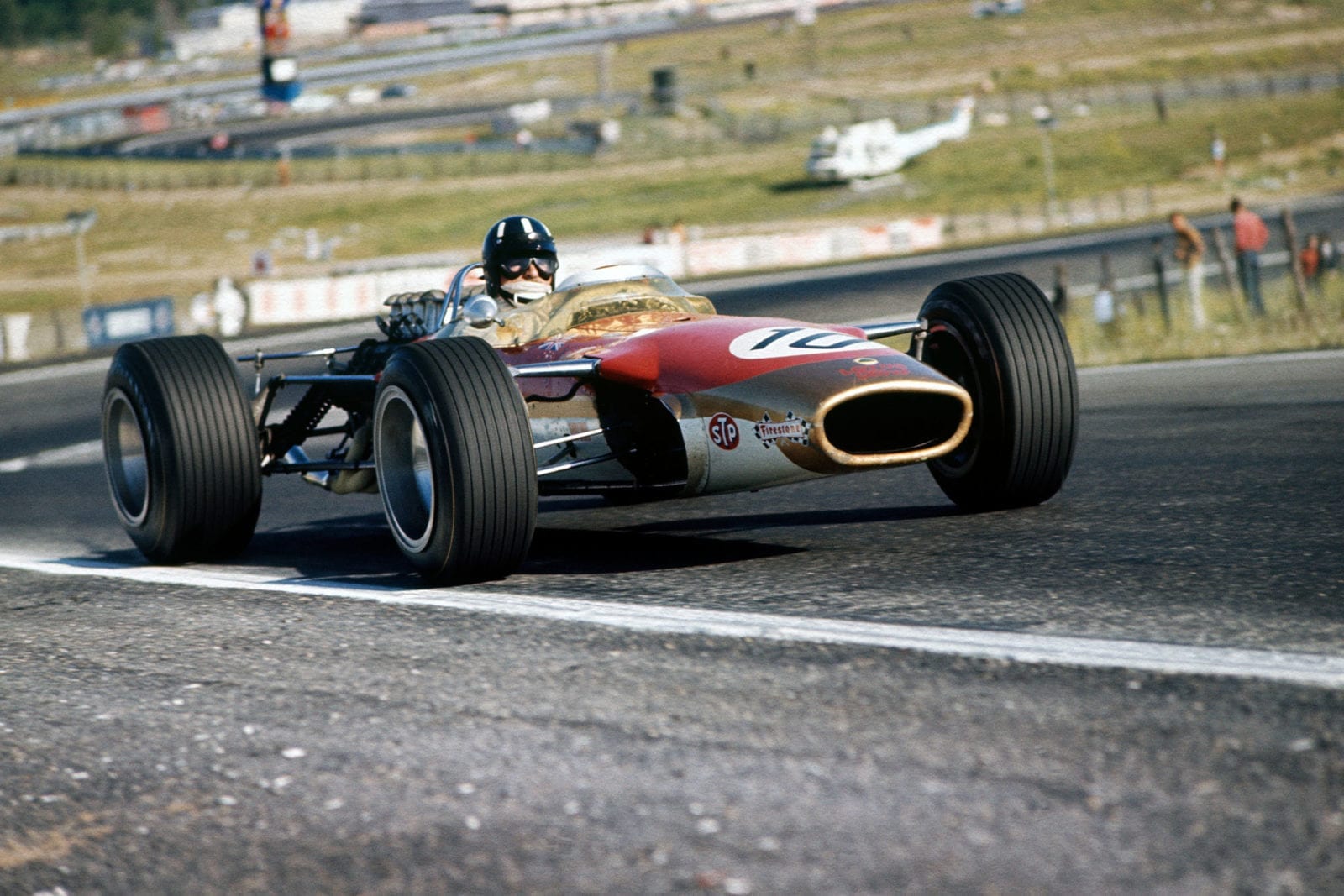
Hill won out in the second race of the season
Motorsport Images
After holding a small Formula One race on the Jarama circuit at the end of last season, the Royal Automobile Club of Spain, and ODACISA the circuit owners, organised the Spanish Grand Prix to be the first European round in the 1968 World Championship series and received support front all the teams except AAR-Eagle.
After some complaints from the drivers’ union about the rubber cones marking the edge of the corners, the loose gravel on the inside of the corners and the height of various guard-rails, a lot of last-minute work put everything right.
All the inside edges were surfaced with tarmac and the line of the corners was marked by bevelled kerbstones neatly fitted into the surface. These stones had radial flutes on them and caused no problems if a wheel ran up them, but there was little grip to be obtained from the fluted surface so there was no encouragement for drivers to run up them except in emergency.
The guard-rails were all lowered to ground level and with the rubber marker cones and loose gravel all gone, everyone was very happy and appreciative of the efforts and cooperation of the Spanish club.
The circuit is very small and twisty, being 3.4 kilometres in length, contained in quite a small stadium-like area and is an artificial man-made layout, like Zandvoort. The installations, though not yet finished in detail are first class and as an artificial race-track it is satisfactory, though small for Grand Prix cars, but Spanish enthusiasts have little choice, for racing on the roads, as in France or Belgium or Italy, is not permitted in Spain.
As would be expected in May, 30 kilometres north of Madrid the sun was hot, though there was a cold niggling mountain breeze blowing most of the time.
Qualifying
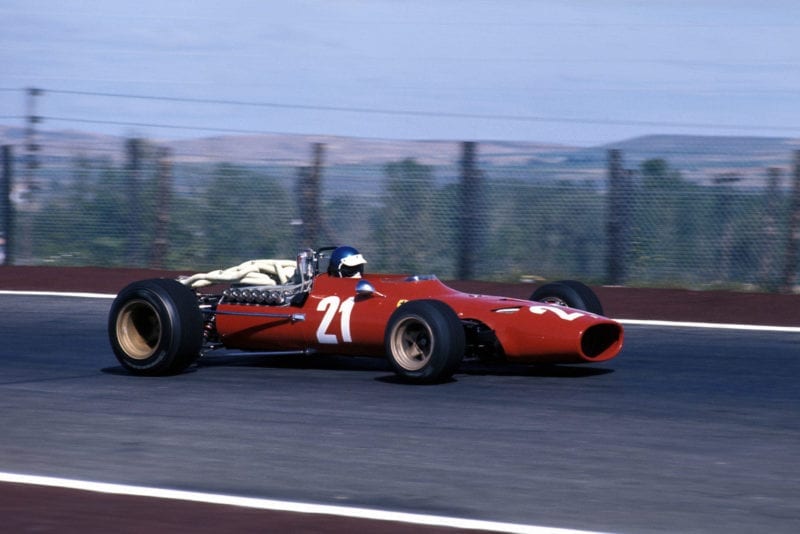
Ickx’s number was changed from 18 to 21 due to a superstitious Ferrari team
Motorsport Images
Practice began on Friday with an hour and a half at mid-day, and a further hour at 4pm, and nearly everyone was ready, only the Brabham team being absent. Their transporter was on its way with Rindt’s car, and Brabham’s brand new car with 4ohc Repco V8 engine was still being completed and a transport aircraft was being readied to fly out with it.
The only other absentee was the Bernard White BRM V12 which Hobbs was entered to drive.
Ferrari arrived and found that Ickx had been allocated number 18 and hurriedly changed it to 21, being superstitious of numbers that have been involved in fatal accidents on their cars.
With Stewart still suffering from his hand injury sustained at the F2 meeting last month at Jarama, Matra arranged that Beltoise should drive the Matra-Cosworth in his place, which was very fortunate for them as their own V12-cylinder-engined car was not ready. It had been entered and Beltoise and Servoz-Gavin had done 1,000-kilomare test run, but it was withdrawn at the last moment.
After their showing at Brands Hatch and Silverstone it was expected that McLaren and Hulme would dominate the meeting with the orange McLaren cars, and they set off to practise together, looking very confident. To some of the drivers the circuit was new, to others it was a question of adjusting from a 1,600cc Formula Two car to a 3,000cc Formula One car and Graham Hill was fortunate in having raced a Lotus 49 on the circuit last November.
“After their showing at Brands Hatch and Silverstone it was expected that McLaren and Hulme would dominate the meeting”
Although the Formula One lap record stood at 1min 28.8sec to the late Jim Clark, set up last year, Beltoise had reduced this to 1min 28.2sec in a Formula Two Matra last month. It was no surprise on this twisty circuit that the Grand Prix cars could not take full advantage of their 400bhp and many of the drivers did not approach the outright lap record.
What was a big surprise for a lot of people was that Rodriguez in the V12 BRM P133-01 got below the record and made fastest lap of the lunch-time session, at 1min 28.1sec, just ahead of Hill in Lotus 49/1.
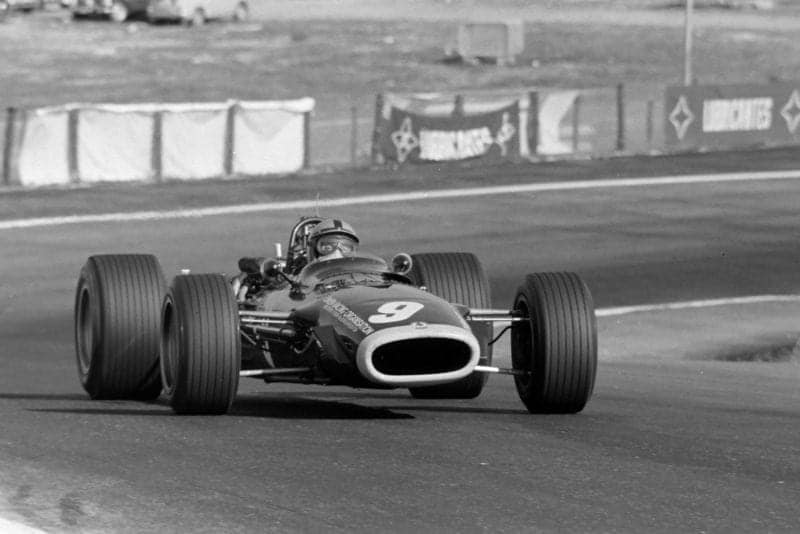
Rodriguez set the early pace in his BRM
Motorsport Images
Redman and Scarfiotti were not quick enough with the Coopers, nor was Ickx with the new Ferrari, but Amon got his red car going better. The new Honda driven by Surtees was noisy but not impressive, the fuel-injection system leaving a lot to be desired in its pick-up from the slow corners.
The Cosworth V8 engines were all fitted with longer inlet trumpets to try to improve low speed acceleration, but it was noticeable that the 12-cylinder Ferrari and BRM engined cars were accelerating much better than the V8-engined ones. Courage was driving the Parnell BRM V12 cautiously, Beltoise was learning to handle the powerful and light Matra-Cosworth V8 very confidently, and Siffert was learning his way round in the Walker/Durfacher Lotus 49, while Rindt was kicking his heels in the paddock waiting for a car.
The Brabham transporter arrived as this practice session ended so that Rindt was able to practise in the late afternoon session, his car being a BT24 to 1967 specification. Rodriguez practised in the second period with his second BRM V12, P133-02, fitted with new designed wheels and wider tyres, but was not so fast, but most other drivers improved on their times as one would expect.
Hulme and Amon scored equal fastest lap with 1min 28.3sec, slower than the F2 record and the earlier time of Rodriguez, but encouraging progress. Redman and Scarfiotti were surprisingly evenly matched, the Honda began to show improvement, but Ickx was not impressive.
Overnight the McLaren team removed the engines from their two cars as they had done their quota of racing miles and installed two new ones, and with Saturday practice at 4pm there was ample time for everyone to get all their work completed, especially as the pits form good, clean, well-lit workshops, avoiding any need to leave the circuit.
The new Brabham BT26 with 4 ohc Repco V8 engine had arrived with Jack Brabham, the McLarens were fitted with pannier fuel tanks on tubular outriggers, though they did not contain petrol as yet, the BRM P133-02 was fitted with the earlier wheels and the Cooper drivers had swopped cars.
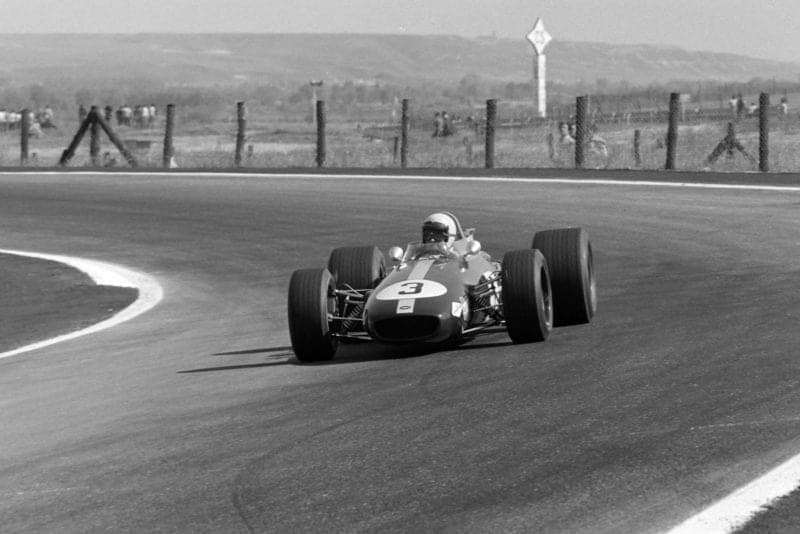
Brabham attempted to qualify his new BT26
Motorsport Images
There was a very adequate one and a half hours of practice and all 14 entries were circulating, but most drivers seemed to have reached their limit and the F2 lap record time was still elusive to most of them.
Hulme soon discarded the pannier tanks on his car, but McLaren continued with them, while both cars had short nose cowlings, as did the Coopers. Beltoise was showing excellent form with the Matra-Cosworth V8, his first meeting with such a powerful car, and he equalled the previous day’s fastest time by Hulme and Amon, whereas Siffert with a similarly powerful car could not approach them, and likewise Ickx could not approach his team-mates’ times.
Amon was really enjoying the tight little circuit and was power-sliding the Ferrari out of the slow corners, while others seemed to be hanging fire. It was no surprise that Amon made best time overall, with 1min 27.9sec but it was not expected that he would be nearly half a second faster than the next best.
Just before practice ended, and when a lot of people thought it was all over, mainly because the track had become very oily after Courage’s BRM had loosened an oil union and spread its oil all over the place, an unfortunate incident occurred. Brabham had been going round relatively slowly as the new car had not done any previous running, and on one lap, when he got to the end of the short main-straight, the brand new Repco V8 went bang and deposited a lot more oil.
McLaren was just behind and he skidded on the oil and struck the guard-rail, writing off the entire front-end of his car. These guard-rails, which are infesting all the circuits of the world, certainly keep the cars on the track and out of the public enclosures but they cause enormous damage to cars that hit them, even when the incident is of a very minor nature.
The Repco engine was a mess, with one piston, cylinder liner, head and valves completely wrecked, so there was no question of Brabham starting in the race. The McLaren was not as bad as it looked at first sight and hard work by the team got it fitted with new suspension members, new steering assembly and new radiator, the only damage to the “monocoque” being one tiny crinkle.
Unfortunately, they did not have a spare set of the latest and widest front wheels so McLaren had to do the race on the earlier narrower ones and this caused excessive understeer, which was not what was wanted on the slow hairpin bends.
Race
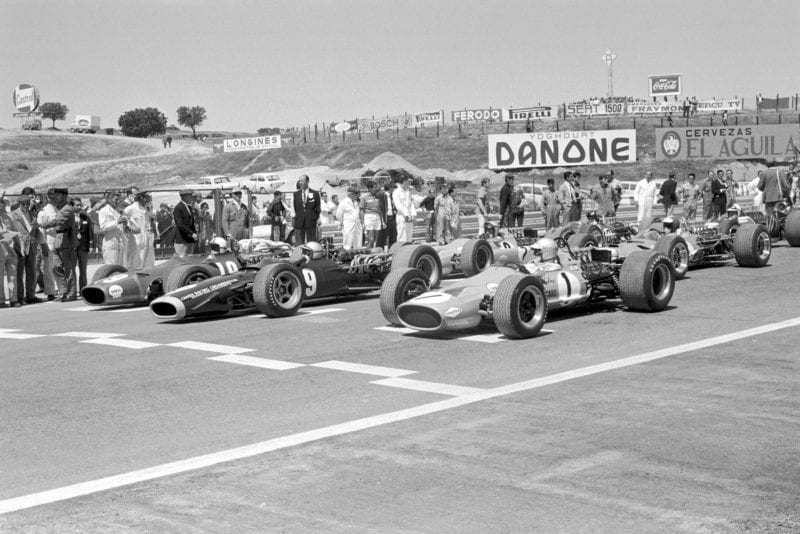
The cras line-up on the grid. Amon took pole, Rodriguez was second and Hulme was 3rd
Motorsport Images
The make-weight Formula Three race was over and done with on Saturday evening, leaving Sunday completely clear for the 90-lap Grand Prix, to be held under a blazing sun, but attended by a poor crowd, in view of the circuit’s proximity to the Spanish capital. Scheduled to start at midday, the 14 cars were allowed a warm-up lap before assembling on the “dummy-grid”, and Rindt was late in joining the other competitors, still being beside the track rather than in his proper place on the grid as the cars moved forward to the starter’s flag.
With Ferrari, BRM and McLaren cars on the front row, McLaren and Matra in row 2, and Lotus, Honda and Ferrari in row 3, the possible outcome was wide open and it was anybody’s race. Rodriguez was driving his faster practice car, P133-01, Redman had Cooper number one, and Scarfiotti number two, Hulme was running without the pannier tanks, but McLaren had his fitted but empty of petrol, running on the chassis tanks and the scuttle tank, and his car was also using the earlier smaller capacity oil tank.
The loss of oil by Courage’s BRM V12 had not done any damage to the engine, and every one of the 13 competitors seemed well prepared, apart from Rindt whose car was fitted with an old engine as a head gasket had leaked at the end of practice and the Austrian driver had driven on until all the water had gone and the engine was scintillating.
“It was Rodriguez who jumped into the lead and he did a scorching opening lap”
It was Rodriguez who jumped into the lead and he did a scorching opening lap, coming round the last right-hand bend into the finishing straight in a beautiful opposite-lock slide, with his rear wheels almost off the edge of the track. He was followed by Beltoise, who had made a superb start, and then came Amon, Hulme, Surtees, McLaren and Hill, with the rest in tow.
Rindt had started late but was driving in his usual spectacular fashion trying to make up the lost ground. After only three laps the first three cars began to pull away, and once Hulme got past the Honda he joined them.
McLaren was finding his excessive understeer embarrassing and could not maintain his opening lap pace, and once Hill had got past him and the Honda the Lotus forged ahead to join the leaders.
At 10 laps the first five cars were running nose-to-tail, in the order BRM (Rodriguez), Matra (Beltoise), Ferrari (Amon), McLaren (Hulme), and Lotus (Hill), the three young rabbits showing the two old hands the way along. After a short gap Surtees led an unhappy McLaren, with Siffert keeping station with them.
The two Coopers were slow but regular and the Ferrari of lckx was not firing evenly, so that Rindt had no trouble in catching these three. Courage’s car was overheating and he stopped on lap 9, and on lap 10 Rindt retired with a loss of oil pressure. Courage rejoined the race some eight laps later.
As the leaders came down the hill to complete the 11th lap a trail of smoke issued from the back of the Cosworth V8 engine in the Matra, but even as it did Beltoise pulled out of the BRM’s slipstream and went into the lead as they braked for the right-hand bend at the end of the short straight.
With oil smoke pouring from the back of the Matra Beltoise stayed in the lead and Rodriguez dropped back a bit, for it was obvious that this situation was not going to last long, and Amon made the most of the position and forced his way by into second place.
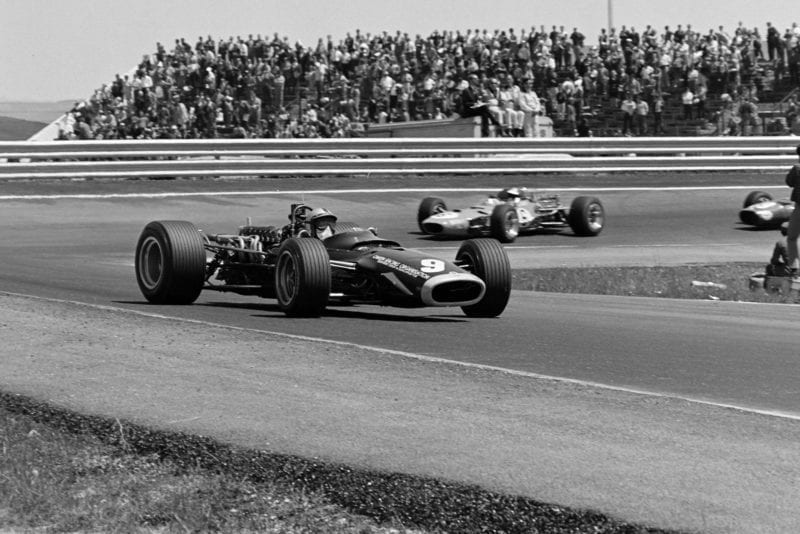
Rodriguez took the lead at the start
Motorsport Images
On lap 13 Siffert lost contact with Surtees and Amon as a petrol tank had sprung a leak and the pedals were wet and slippery, making things difficult for him, and on the same lap Ickx pulled into the pits with a misfiring engine and retired, part of the ignition distributor having broken.
The smoking Matra held the lead until lap 15 and at the end of the next lap Beltoise pulled into the pits, letting all the others go by, with Amon in the lead. Mechanics searched for the source of the oil leak, which was from the oil filter, tightened it, and he went off again, but there was still smoke and after one lap he was back.
The car was jacked up and mechanics got underneath to replace the sealing ring on the oil filter, and many laps went by. While Beltoise was in and out of the pits, Courage set off again, his cooling system having settled down, and meanwhile Amon was keeping ahead of Rodriguez, Hill and Hulme.
A considerable way back and unable to make much impression on anyone was Surtees with the new Honda, followed painfully by McLaren, and Siffert, while the two Coopers brought up the rear, soon to be lapped by the leader.
After 25 laps the petrol leak in the Lotus cockpit was becoming impossible, so Siffert stopped and had the leaking tank isolated from the system, and at this point Rodriguez decided it was time he tried to get back in the lead and for four laps he harried the Ferrari, but there was no way past.
“Rodriguez overdid things on braking for a long right-hand bend and shot off the road and through the first wire-mesh fence”
On the 28th lap, just as Beltoise had rejoined the race with the oil leak cured, Rodriguez overdid things on braking for a long right-hand bend and shot off the road and through the first wire-mesh fence, and finished up against the second one with the car in a horrible mess but himself unscathed.
This gave Amon a clear run, for while the BRM had been pressing him they had drawn away from the Lotus of Graham Hill and Hulme’s McLaren. Steadily the gap increased from a few seconds to 12 seconds, then to 15, and at 45 laps, which was half-distance, the Ferrari was 16 seconds ahead of the Lotus and still drawing away.
The race now settled down into a drawn-out procession, with the Ferrari pulling away at one second a lap, without straining and lapping at just under 1min 30sec, while Hill and Hulme seemed to have reached stalemate. Surtees was too far back to be of ally consequence, and McLaren was just keeping going. The Coopers had both been lapped by the Ferrari, and even by the Honda, and were running in close company, and on lap 59 Redman suddenly nipped in front of Scarfiotti.
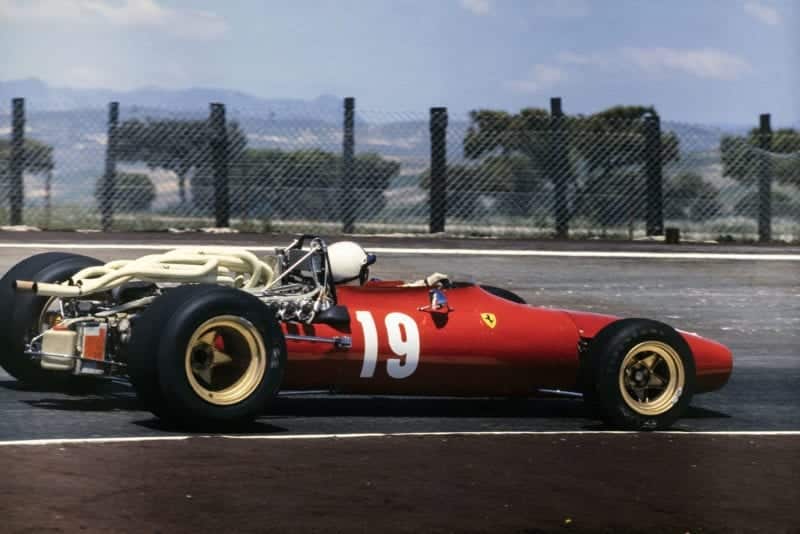
Amon took the lead after Rodriguez crashed out
Motorsport Images
The Matra was going perfectly after its stop and Beltoise was driving harder than anyone, even though he could not hope to make up the time lost. However, his efforts rewarded him with the fastest lap, and he made full use of the time to put in some excellent practice, for this was his first race in a 3-litre Grand Prix car.
Siffert was not going anything like as fast and stopped when the transmission started to rumble and vibrate; after a few more laps it was getting worse, so the car was withdrawn before something broke.
“The usually reliable Ferrari, which seemed certain to win, died on the hill behind the pits”
Courage refired out on the circuit when the fuel-injection unit broke down, and hardly had all this happened than the usually reliable Ferrari, which seemed certain to win, died on the hill behind the pits. The petrol pump taking fuel from the tanks to the high-pressure unit had given up, and Amon had no choice but to walk back and watch Hill in the lead on lap 58.
There were now only eight cars running, in the order Hill (Lotus), Hulme (McLaren), Surtees (Honda), McLaren (McLaren), all on the same lap, with Redman (Cooper) and Scarfiotti (Cooper) a lap down, followed by the ailing Lotus of Siffert, that was about to retire, and the healthy Matra of Beltoise, going faster than anybody, but nine laps behind.
At 64 laps Hulme decided to attack Hill, and for five laps he pressed hard on the tail of the Lotus, but the little circuit did not allow room anywhere for out-fumbling Hill, and the Lotus driver was not making any mistakes. They were fast catching McLaren, who was now in trouble with a cracked oil-breather pipe on his Cosworth V8 engine, so that on left-hand bends he was losing a lot of oil, and smoke was issuing as the oil fell on the exhaust pipes.
Hill and Hulme could see that they were soon to lap McLaren, and the New Zealander thought it might give him the opportunity to slip by into the lead, while the Lotus driver realised that if McLaren played things right he could help his team-mate and cause a little obstruction, which is all quite fair in open battle, so he began to get ready for a little rough-and-tumble.
On lap 72 they were about to lap McLaren when all the tension disappeared, for he drew into the side and almost stopped, waving them both by, so that Hulme had no help at all. As long as Hill did not make any mistakes it was stale-mate again and the two Cosworth-powered cars toured round nose-to-tail.
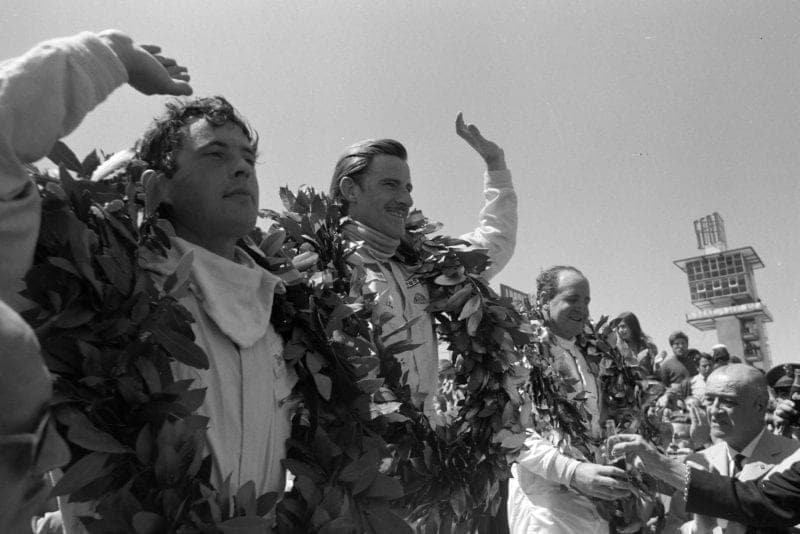
Hill (centre) enjoys his win on the podium, with Hulme 2nd (right) and Redman 3rd (left)
Motorsport Images
The Honda was over half a minute behind them, in a poor third place, when there was a “graunching” noise on the slow part of the circuit behind the pits and the gearbox broke. The fact that Surtees could not get into any gear suggested that part of the selector mechanism may have broken off and fallen in amongst the internals.
“Hulme had had enough of sitting in the exhaust fumes of the Lotus, leaving Hill to tour home to a very popular victory”
Whatever it was, it was the end of the Honda, and a few laps later McLaren’s engine had lost so much oil that oil pressure was almost nil, and as the engine showed signs of seizing he switched off and walked back to the pits. All this left the two Coopers in third and fourth places, profiting from sheer reliability.
In the last 10 laps Hulme had had enough of sitting in the exhaust fumes of the Lotus, added to which his gearbox would not engage 2nd gear, so he eased right off, leaving Hill to tour home to a very popular victory, these two being the only ones to complete the full 90 laps.
Everyone was very pleased with the outcome, for just at this time Team Lotus are going through a bad period and needed the morale booster that it gave them.
Jarama Jottings
- It seems that some members of the drivers’ trade union, the GPDA, tried to get the race cancelled, on safety grounds. All was put in order by ODACISA and the President and Secretary of the GPDA were conspicuous by their absence, leaving the members to look after themselves.
- Some Fleet Street daily paper Scandal-mongers arrived expecting a big fuss over starting money, qualifying, safety precautions and so on. When nothing happened they looked very bored watching the racing cars.
- The pits were kept admirably clear of photographers who do not take photos, reporters who do not report, and hangers-on and camp-followers during the race, so that the paying customers and those in the Press Stand could actually see what was going on.
- Our Formula Two reporter has enthused over the pits construction, where each pit is in fact a workshop facing onto the pit apron and backing onto the paddock. Justifiable enthusiasm; and the sooner Brands Hatch and Silverstone organisers go to Spain to see how it should be done, the better for British motor racing.
- Certain “well-informed circles” were saying that the crowds stole parts off the crashed BRM. It was not true, they merely took pieces of the shattered glass-fibre nose cowling that flew over the fence. The same “circles” were saying that there wasn’t a flag signal to be seen during practice. Again untrue.
- The officials of the GPDA objected to the idea of two Spanish Formula Two drivers taking part, but not to Courage and Redman, whose Grand Prix experience is very limited.
- On the starting grid are shown the best practice time for each driver, as is normal, and underneath in brackets the fastest lap recorded during the race. They make for interesting study and indicate that the newcomers are still learning as they were the only ones to go faster in the race. Beltoise would seem to have reached his limit for the conditions.
